Banksia rose is a globally famed species from the rose family that features luscious evergreen fern-like leaves that sit amidst the plant's creamy-yellow fragrant flowers that are borne as miniature double flowers with prolific petals in Spring.
I absolutely adore roses just as much as the next gardener but let’s be honest, many species of rose can be a little tricky to grow and care for. That’s not the case with this specifically cultivated species.
It grows vigorously with a shrubby climbing habit, perfect for many decorative applications in gardens.
In this article, I have the pleasure of detailing how you can grow and care for this notoriously beautiful rose species that is a garden favourite globally.
More...
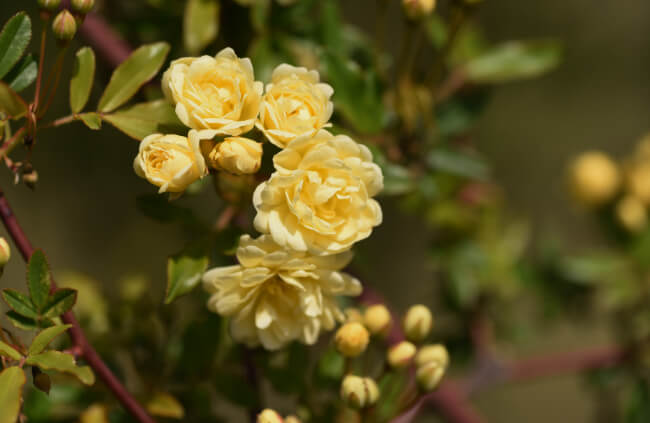
Family: | Rosaceae |
|---|---|
Genus: | Rosa |
Species: | R. banksiae |
Common Names: | Banksia Rose, Lady Banks’ Rose |
Origin: | China |
Location: | Outdoor |
Type: | Evergreen climbing rose |
Growth: | 6 to 9 metres tall and wide |
Sun requirements: | Full sun to light shade |
Foliage Colour: | Green |
Flower Colour: | Creamy-yellow (other varieties available) |
Flowering: | Spring |
Maintenance level: | Low |
Poisonous for pets: | Non-toxic to cats and dogs |
Introducing Banksia Rose
Unlike most roses, the banksia rose is mostly thornless, making it an excellent pick for yards that have children and pets frequenting the spaces. Apart from its prolific flowering capability, the plant is also one of the easiest flowering roses to grow with blooms that are said to smell similar to violets.
Enjoy impressive clusters of creamy-yellow flowers with this evergreen climbing rose.
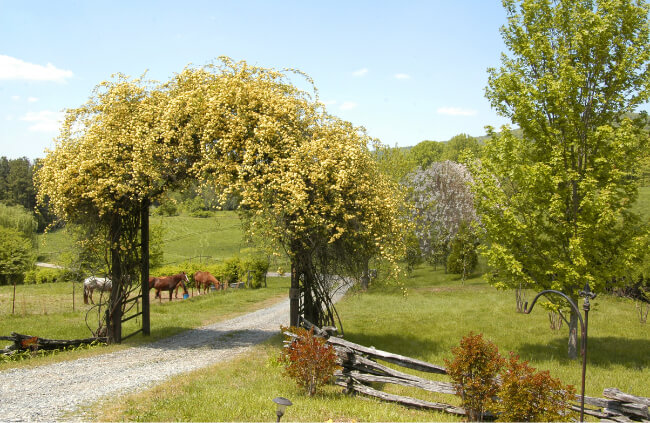
Banksia Rose Plant Details
Biologically labelled Rosa banksiae, the species is now commonly known as the Banksia Rose or the Lady Banks’ Rose, named after the wife of the famous botanist Sir Joseph Banks, Mrs Dorothea Lady Banks.
Part of the Rosaceae family, the plant is native to central and western China where it is thought to have been grown in gardens for hundreds of years. Today, it is a widely cultivated rose species in cool to tropical regions around the world. However, it tends to perform best in cool to warm temperate climates.
Being a vigorous and fast-growing species, this plant will typically grow to around 6 to 9 metres tall and wide in gardens with a spreading and climbing habit.
It is good to note that in cooler climates, the plant may become more deciduous and lose its leaves during winter. In Australia, it should perform reliably as an evergreen in most states.
Banksia roses will usually flower from years 2 to 3 and should be a low-maintenance addition to your garden once established.
Landscaping with Lady Banks’ Rose
This rose is most commonly used as a spreader and climber where its characteristics will truly shine in gardens. It is excellent for covering fences, arches, and walls or for gardening with trellises.
It can also be used as an attractive groundcover rose in sunny gardens and makes for a quintessential cottage garden flower.
Popular Banksia Rose Varieties
The traditional banksia rose produces clusters of creamy-yellow blooms with hues of white and yellow. Two notable varieties have been developed that split these flower colours into their own cultivars.


Get Your Free Guide:
Master Growing Australian Natives eBook
A Must Have Complete Guide for Every Australian Garden
Get Your Free Guide:
Master Growing Australian Natives eBook
A Must Have Complete Guide for Every Australian Garden
Rosa banksiae ‘Lutea’
Known as the Yellow Banksia Rose, this variety sports huge profusions of multi-petalled buttery-yellow blooms that are borne as double flowers. The lightly scented blooms are delicately displayed on the plant's thornless, slender branches with clads of rich green foliage of small, smooth leaves.
This plant will grow to about 4 to 6 metres tall with a spread of up to 3 metres.
Rosa banksiae ‘Alba Plena’
Known as the White Lady Banks’ rose, this gorgeous variety is a vigorous climber that features rich green foliage adorned with large clusters of miniature double white blooms from spring to early summer.
Its branches are slender and smooth, offering lovely texture and colour to gardens throughout most of the year. This variety will usually grow up to 4.5 metres tall with a spread of up to 2.5 metres.
How to Grow Lady Banks' Rose
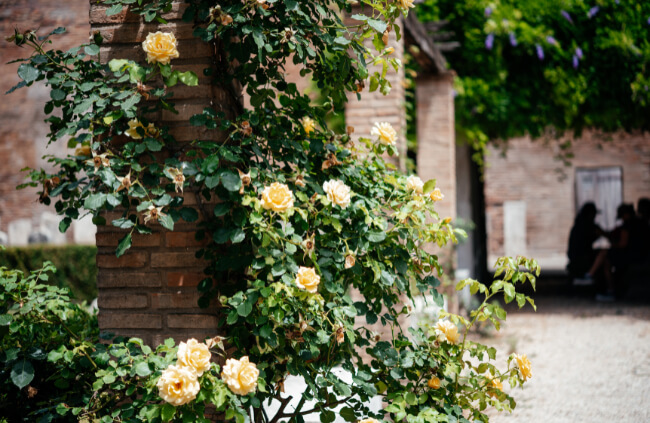
Propagation of this rose is typically done best using softwood or hardwood cuttings. Alternatively, buying and establishing a healthy nursery plant is also always an easier and faster method to having a flowering specimen in your garden.
Propagating Rosa banksiae Using Softwood Cuttings
- Softwood cuttings should be taken during the active season in spring to early summer and should be at least 12 to 15 centimetres in length.
- Prepare a well-drained container filled with a rich potting mix.
- Plant your cutting into the mix and water well.
- Place in a warm and sheltered location that gets bright indirect light.
- Once your cutting has rooted, move it to a bigger pot for transplanting in late spring or autumn.
Propagating Banksia Rose Using Hardwood Cuttings
- Take hardwood cuttings during the winter dormancy period.
- Keep them in a dry and cool location indoors.
- Once early spring comes around, prepare a sunny planting location in your garden by digging some well-rotted manure or compost into the soil.
- Dip the cutting into some rooting hormone then plant your hardwood cutting directly into the ground, watering well afterwards.
- You can plant as early as about six weeks before the last frost.
- Keep the cutting lightly moist throughout its first active season and feed with a slow-release fertiliser in early summer.
Ideal Growing Conditions for Lady Banks’ Rose
For your initial planting, this rose is best planted in spring after the risk of frosts has subsided. Thereafter, it will require some basic growing conditions to thrive, look its best and flower properly.

Best Soil to Use
While it can tolerate a wide range of soil types, it does prefer well-draining moist soil that is rich in organic matter. It is best to dig some manure or well-rotted compost into your soil before planting.
If you find your soil becoming too compacted over time, you can consider gently aerating the soil occasionally to ensure the rose is getting sufficient water and nutrients.
Sunlight Needs
Full sun to light shade is preferred. The more full sun the plant gets, the more vigorous it will grow and the more prolific the flowering periods will be. Pick a sunny location in the garden for the best results.
General Environment
This species of rose enjoys cool, ventilated environments and is not very tolerant of high temperatures. Its ideal temperature range is between 15°C and 26°C. When it comes to the amount of sun each day, aim for about 6 to 8 hours of direct sun with some afternoon shade.
Banksia Rose Care Guide
This species is easier to care for than other cultivated rose species, making it a great pick for any gardener regardless of experience.
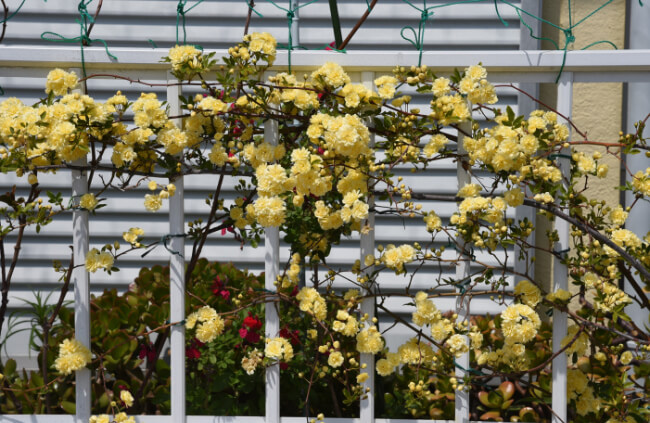
Watering Needs
Keep moist and well-watered in the plants' first year until established and during dry spells. Try to avoid water-logged soil. Provide supplemental irrigation once or twice per week during hot weather. Cut back on watering during winter. Water only when the soil has dried out.
How to Prune Lady Banks' Rose
It is best to prune immediately after flowering in spring to early summer. The thornless stems will make it easier to handle this rose. Prune to keep shape and encourage vigorous growth.
Annual pruning may not be required but it is important to prune in spring to early summer as the flowers are borne on last season's growth so winter pruning will mean a possible absence of blooms next season. Remove damaged branches as needed.
Fertiliser and Mulch
Feed with a slow-release or formulated rose fertiliser during the active growing season in spring. It can be beneficial to add a small layer of organic mulch around the plant in early summer to assist with healthy moisture levels. Try to keep the mulch away from the main stem.
Possible Banksia Rose Problems
Thankfully, this species is mostly disease resistant, especially in good conditions. In overly humid environments, powdery mildew could become an issue.
Powdery mildew is a fungus that attacks the leaves, stems and flowers of roses. Young growth is typically affected the most. It appears as reddish blistered areas on the upper sides of leaves which is followed by powdery white growth on all parts of the affected plant.
In light cases, you can try just spraying it off with water on a warm, dry day. However, this fungus often reappears so I would recommend treating your roses with a quality neem oil spray. Severe infection may require retreatment but neem oil does tend to completely get rid of powdery mildew with some time.
Banksia Rose Frequently Asked Questions
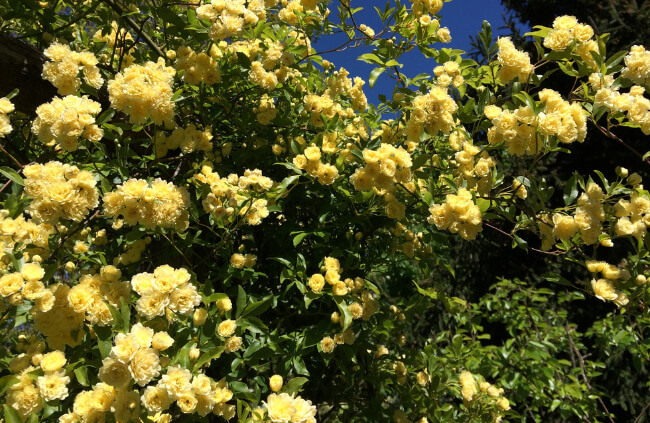
Does banksia rose have a scent?
Yes, its blooms are small and borne as double flowers that are heavily petalled. These flowers are said to have a subtle scent similar to violets.
Is banksia rose repeat flowering?
Yes, as long as you prune at the right time of the year. Since its flowers are produced on the last season's growth, winter pruning should be avoided as this will mean the plant may have more of an absence of flowers next season.
It’s best to prune immediately after flowering in spring to early summer for repeat flowering next season.
What is the best position for a banksia rose?
This rose species requires a sunny position to flower well and look its best. While it can tolerate light shade, try to aim for about 6 to 8 hours of direct sunlight each day with some afternoon shade.
What colours do banksia roses come in?
The parent species, Rosa banksiae, produces creamy-yellow blooms. Two variations of this plant have been cultivated having either single white or double yellow flowers.
How long does the Lady Banks' rose bloom?
This rose is one of the earliest roses to flower, often staying in bloom for several weeks and even up to a month in good conditions.
Is Lady Banks’ rose a true rose?
Yes, this species is a true rose, part of the Rosaceae family. It was first introduced in the early 1800s, making it a long-lived and vigorous species. Though a little unusual botanically from other roses, it is a truly unique rose species for gardens.
Why won’t my Lady Banks’ rose bloom?
An excess of nitrogen in the soil can lead to this species producing a lot of leaves but fewer flowers. Be sure to try using balanced soil and fertiliser for optimal growth.
Why are the leaves on my Lady Banks’ rose turning brown?
Overwatering this plant can cause its leaves to turn brownish-yellow and fall off. The roots require healthy oxygen levels so keeping them too wet can cause them to rot. Be sure to let the soil dry out before watering and only apply small layers of mulch around the plant each time.
If you’re interested in growing some Australian native flowers alongside your roses, be sure to check out our informative guide below for more:
Enjoy One of the Most Unique and Favoured Roses with Banksia Rose
Whether for its prolific cheerful blooms, its dainty fern-like foliage or its practical climbing habit, the banksia rose truly has a lot to offer gardens. It can add gorgeous bursts of colour to walls, fences, arches or trellises in spring while maintaining a luscious appearance throughout most of the year, easily elevating outdoor spaces.
If you’ve always wanted beautiful roses in your garden without the hassle of high maintenance, this species is the perfect pick for you. Enjoy one of the world's most treasured roses with the bountiful and buoyant banksia rose.
Published on June 19, 2023 by Maisie Blevins
Last Updated on September 19, 2024




